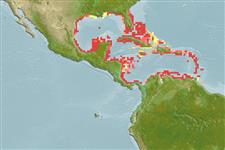Actinopterygii (ray-finned fishes) >
Tetraodontiformes (Puffers and filefishes) >
Tetraodontidae (Puffers) > Tetraodontinae
Etymology: Sphoeroides: Greek, sphaira = ball + Greek, suffix, oides = similar to (Ref. 45335).
Environment / Climate / Range
Ecology
Marine; brackish; reef-associated; depth range 0 - 11 m (Ref. 9710). Subtropical, preferred ?; 31°N - 9°N, 98°W - 59°W
Western Atlantic: northeastern Florida and northern Gulf of Mexico in the USA and the Bahamas to Campeche in Mexico and Lesser Antilles. Taxonomic status of populations from northern South America to Brazil uncertain.
Size / Weight / Age
Maturity: Lm ? range ? - ? cm
Max length : 30.0 cm TL male/unsexed; (Ref. 7251); common length : 20.0 cm TL male/unsexed; (Ref. 3821)
Short description
Morphology | Morphometrics
Dorsal
spines
(total): 0;
Dorsal
soft rays
(total): 8;
Anal
spines: 0;
Anal
soft rays: 7. Upper side brown with large dark grey to black spots and light (pale blue or green in fresh specimens) irregular-shaped reticulations. Lower side with an irregular row of dusky to black rounded spots. The axil spot the most intense in the series. Sexually mature, ripe males sometimes covered with brilliant red or orange spots of about 1 mm in diameter (white in preserved specimen). No lappets on head or body (Ref 53033).
Inhabits bays, estuaries and protected coastal waters. Feeds primarily on shellfish, also on some finfish (Ref. 3821).
Life cycle and mating behavior
Maturity | Reproduction | Spawning | Eggs | Fecundity | Larvae
Robins, C.R. and G.C. Ray, 1986. A field guide to Atlantic coast fishes of North America. Houghton Mifflin Company, Boston, U.S.A. 354 p. (Ref. 7251)
IUCN Red List Status (Ref. 115185)
CITES (Ref. 94142)
Not Evaluated
Threat to humans
Harmless
Human uses
Fisheries: subsistence fisheries
More information
Age/SizeGrowthLength-weightLength-lengthLength-frequenciesMorphometricsMorphologyLarvaeLarval dynamicsRecruitmentAbundance
ReferencesAquacultureAquaculture profileStrainsGeneticsAllele frequenciesHeritabilityDiseasesProcessingMass conversion
Tools
Special reports
Download XML
Internet sources
